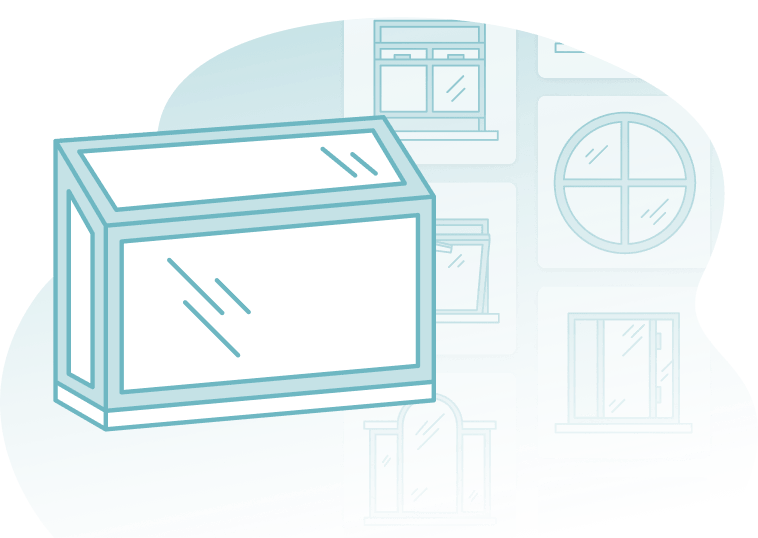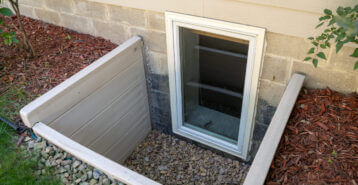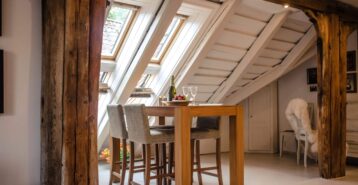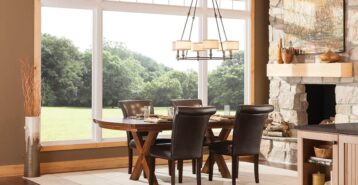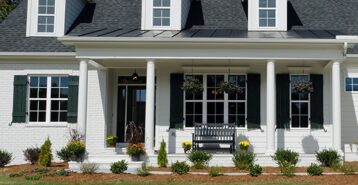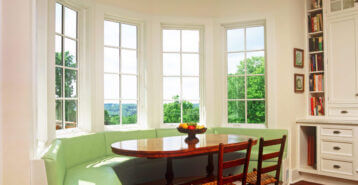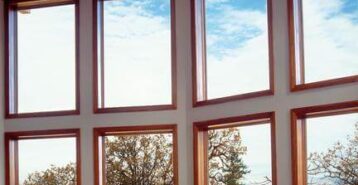Average Garden Window Cost
Garden windows enhance any home by bringing in natural light, additional space, and a connection to the outdoors. Their unique design makes them a beautiful focal point. However, they tend to be more expensive than other window types. This guide breaks down the cost factors of garden windows, including pricing by size, frame material, and glass type.
As of 2025, the average cost to install a garden window is approximately $4,100, with most projects ranging between $1,350 and $6,800, including professional installation. The total price depends on quality, brand, and frame material.
The higher end of this range applies to new installations. More labor-intensive, they require cutting a new wall opening or expanding an existing space. Costs may also rise if the installation involves:
- Structural modifications
- Water damage repairs
- Other construction work
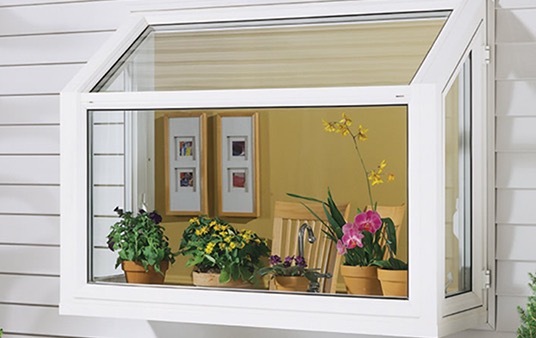
Your final project cost can vary significantly for garden window installation and will depend on a few factors:
- The size of the window
- Window brand
- Framing material
- Type of glass
- Customizations
- Any required demolition or construction work
Garden Window Cost Per Square Foot
You’ll typically pay around $25 to $75 per square foot for a garden window, depending the above factors. See the table under Factors Affecting Garden Window Costs for a full breakdown.
Factors Affecting Garden Window Costs
Now that you have an idea of average costs, let’s explore what will impact the price of your garden window installation.
Some factors have a greater influence on cost, while others have a smaller impact. Understanding where you can adjust your choices — such as frame material, glass type, or window size — can help you balance quality and budget to find the best option for your home.
| Factor | Description | Impact on Cost |
|---|---|---|
| Size | Larger windows require more materials and labor, increasing the cost. | High |
| Material | Common materials include vinyl, aluminum, and wood, each varying in price and durability. | Moderate to High |
| Glass Type | Options like double-glazing or energy-efficient coatings can affect pricing. | Moderate |
| Features | Additional features such as built-in shelves, opening mechanisms, or decorative elements. | Moderate to High |
| Brand | Premium brands may offer enhanced aesthetics or durability but at a higher price. | Variable |
| Installation | Complexity of installation can vary; professional installation is recommended. | High |
Let’s dive into these details in the next few sections.
Garden Window Sizes and Costs
The size of your garden window plays a significant role in its cost. If you’re replacing an existing garden window, then you will likely find it is most cost-effective to keep the size the same. However, if you are installing a new one, then you’ll find a smaller size will have a dramatic impact on saving.
Here’s a breakdown:
| Window Size (Width x Height) | Average Cost |
|---|---|
| Small (24" x 36") | $900 - $1,200 |
| Medium (36" x 36") | $800 - $1,000 |
| Large (48" x 36") | $1,200 - $1,500 |
| Custom Size | Varies, typically starts at $1,000 |
What’s the Most Popular Size for Garden Windows?
The most popular or common size for garden windows typically falls within the medium range, with dimensions around 36 inches wide by 36 inches high.
This size offers ample space for plants and decorative items, allows for lots of natural light, and can usually fit in the space above kitchen sinks, which is where garden windows are most frequently installed.
What Else to Know About Sizes
Garden windows are generally smaller than standard double-hung or bay windows, but they still come in a range of sizes to suit different spaces.
Standard garden window sizes start as small as 24 inches x 24 inches and can go up to 72 inches x 60 inches for larger installations. Many manufacturers also offer custom sizes, allowing you to find the perfect fit for your window opening and home design.
To learn more, you can visit our guide on standard window sizes.
Garden Window Prices by Frame Material
The choice of material for the frame significantly impacts both the cost as well as your window’s longevity and maintenance needs.
Here’s a look at the average cost range of the five most popular window frame materials:
| Material | Average Cost Range | Characteristics |
|---|---|---|
| Vinyl | $600 - $1,200 | Durable, low maintenance, good insulation, cost-effective. |
| Wood | $900 - $1,700 | Aesthetically pleasing, natural insulator, requires more maintenance. |
| Aluminum | $700 - $1,400 | Lightweight, strong, less energy efficient, prone to condensation. |
| Composite | $1,100 - $2,000 | Blend of wood fibers and plastic, low maintenance, resembles wood. |
| Fiberglass | $1,300 - $2,700 | Very durable, excellent insulation, low maintenance, can be painted. |
How to Decide Which Frame Type is Best
Each frame type has benefits and drawbacks. You’ll have to decide which material is the best one for your budget and your home.
- Vinyl: Vinyl frames are one of the most popular choices due to their durability, low maintenance requirements, and affordability. They offer good thermal insulation and come in various colors, though the selection is not as broad as painted wood or fiberglass.
- Wood: Wood frames provide a classic, natural look that many homeowners love. They offer excellent natural insulation and can be stained or painted to match any decor. However, they require regular maintenance to prevent decay, warping, or termite damage.
- Aluminum: Aluminum frames are known for their strength and slim profile, allowing for more glass area. They’re less expensive than wood and fiberglass but offer poor thermal insulation and can condense moisture.
- Composite: Composite frames are made from a mixture of wood fibers and plastic, designed to offer the best qualities of both materials. They are durable, with minimal expansion and contraction, and require less maintenance than wood, while still providing a similar aesthetic.
- Fiberglass: Fiberglass frames are among the most durable and energy-efficient options. They can withstand temperature extremes without warping, cracking, or fading. Fiberglass frames are low maintenance and can be painted, offering a high degree of customization.
You can read more about frame types, explore their costs, and even take our quiz to get our recommendation on which material is your ideal fit by visiting our guide to window frame types.
Cost Increases by Glass Options
Garden window glass replacement options can affect both the cost and the window’s energy efficiency. Here’s a look at what you can expect to add your project’s bottom line by choosing from various glass options:
| Glass Type | Average Cost Increase | Benefits |
|---|---|---|
| Double Glazing | $120 - $250 | Improved insulation, reduces heat loss, better noise reduction. |
| Triple Glazing | $250 - $450 | Superior insulation, enhanced noise reduction, increased security. |
| Low-E Glass | $180 - $350 | Reflects infrared light, keeping rooms warmer in winter and cooler in summer, reduces UV damage to fabrics. |
| Gas-Filled Glass | $220 - $400 | Gas like argon or krypton between panes increases insulation, reduces heat transfer. |
What Glass Options Should I Consider?
- Double Glazing: The standard for most modern windows. It offers a significant improvement over single-glazed windows in terms of insulation and noise reduction. You can read more about double-pane windows over at our guide.
- Triple Glazing: This adds an additional glass pane and air space. You’ll benefit from the highest levels of insulation and noise reduction. This makes triple glazing great for cold climates or noisy areas. Our guide to triple-pane windows can tell you more.
- Low-E Glass: Contains a microscopically thin coating that reflects thermal radiation. It helps keep heat inside during winter and outside during summer, making it an energy-efficient choice year-round. We created a guide to understanding low-E glass if you’d like to learn more.
- Gas-Filled Glass: These units use inert gases like argon or krypton between the panes instead of air. This can further reduce heat transfer and improve thermal performance. The gases are denser than air, providing better insulation and energy efficiency.
Remember, the best glass option for your garden window will depend on your needs. Consider your climate, orientation of the window (e.g., south-facing windows might benefit more from Low-E glass), and budget. Upgrading the glass can significantly enhance the window’s energy efficiency. This often leads to savings on heating and cooling costs over time. You can visit our guide to glass types to learn more about all the options above.
The Final Word
When you’re installing or replacing a window, you should choose the window type (like a garden window) first. Then, move on to the frame, and then the glass. A contractor can help you with all those decisions.
If you’re ready to get quotes for a garden window, plan to reach out to three or four contractors to find someone with the right experience at the right price. You can use our contractor directory to browse through the pros available near you and connect with them for quotes.
You can also have Modernize do the research for you. Tap the button below and answer a few questions about your project to be matched with up to four pre-vetted professionals.
Compare top-rated windows pros in your area.
Read real homeowner reviews, explore qualifications, and view promotions. Modernize makes it easy to browse professionals and find one that will be perfect for your project.
